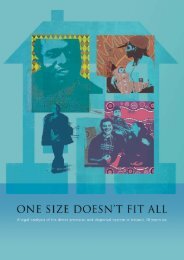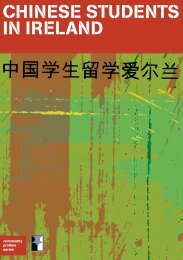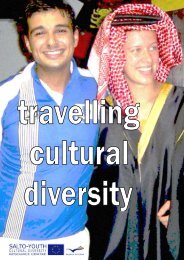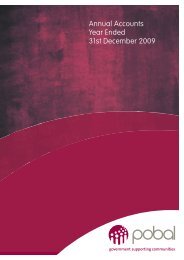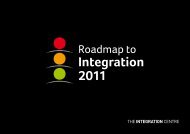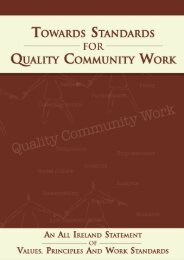Intercultural Education in the Post-Primary School - National Council ...
Intercultural Education in the Post-Primary School - National Council ...
Intercultural Education in the Post-Primary School - National Council ...
You also want an ePaper? Increase the reach of your titles
YUMPU automatically turns print PDFs into web optimized ePapers that Google loves.
SIMILARITY AND DIFFERENCEAll education recognises <strong>the</strong> uniqueness of<strong>in</strong>dividuals, <strong>in</strong> terms of <strong>the</strong>ir own personalhistory, experiences, wants and needs. Partof our uniqueness is that we are allmembers of particular social groups, whichmeans that we share some experiences,wants and needs with o<strong>the</strong>r members ofthose groups. Different cultural, languageor ethnic groups often have diverseexperiences and needs. A fair society is onethat can cater for both people’s<strong>in</strong>dividuality and <strong>the</strong>ir shared identities.As <strong>the</strong> Commission on <strong>the</strong> Future ofMulti-Ethnic Brita<strong>in</strong> (The Parekh Report)has noted:S<strong>in</strong>ce citizens have different needs, equaltreatment requires full account to be takenof <strong>the</strong>ir differences. When equality ignoresrelevant differences and <strong>in</strong>sists onuniformity of treatment, it leads to<strong>in</strong>justice and <strong>in</strong>equality; when differencesignore <strong>the</strong> demands of equality, thatresults <strong>in</strong> discrim<strong>in</strong>ation. Equality must bedef<strong>in</strong>ed <strong>in</strong> a culturally sensitive way andapplied <strong>in</strong> a discrim<strong>in</strong>at<strong>in</strong>g but notdiscrim<strong>in</strong>atory manner.Culture does not def<strong>in</strong>e us or determ<strong>in</strong>e us.With<strong>in</strong> <strong>the</strong> white Irish settled population<strong>the</strong>re is a great deal of diversity of values,beliefs and ways of life. O<strong>the</strong>r ethnic andnational groups also display a great deal ofdiversity. Recognis<strong>in</strong>g this is important <strong>in</strong>overcom<strong>in</strong>g stereotyp<strong>in</strong>g.A person is not simply def<strong>in</strong>ed by oneaspect of <strong>the</strong>ir lives. People’s identities arecomplex and made up of many layers. Aperson can be at <strong>the</strong> same time, a mo<strong>the</strong>r, aTraveller, a childcare worker, an artist, asister, an Irish person, a fan of ‘anyone butManchester United’. Usually we havesometh<strong>in</strong>g <strong>in</strong> common with members ofo<strong>the</strong>r groups and should <strong>the</strong>refore be ableto relate to and empathise with <strong>the</strong>m. Suchfactors need to be explored, <strong>in</strong> order tobreak down <strong>the</strong> limit<strong>in</strong>g and stereotyp<strong>in</strong>gof people that can take place.For young children, an awareness thathumanity conta<strong>in</strong>s great diversity and that<strong>the</strong>re is no one way of life that is ‘normal’will be developed through <strong>the</strong>ir explorationof <strong>the</strong> world around <strong>the</strong>m, and through<strong>the</strong>ir be<strong>in</strong>g exposed to a rich and diversemix of images and cultural artefacts. Aschildren progress through school <strong>the</strong>y willbecome <strong>in</strong>creas<strong>in</strong>gly aware of <strong>the</strong> variouscultures that have contributed to Irishnessthrough <strong>the</strong>ir <strong>in</strong>fluence on our arts <strong>in</strong> bothIrish and English (and <strong>the</strong> <strong>in</strong>terfacebetween <strong>the</strong> two), our values, ourma<strong>the</strong>matics, our technology and on <strong>the</strong>ways <strong>in</strong> which we benefit from <strong>the</strong> <strong>in</strong>terpenetrationof cultures.It <strong>the</strong> early stages of primary schoolchildren can come to realise <strong>the</strong> ways <strong>in</strong>which images and accounts are framed.Dur<strong>in</strong>g <strong>the</strong>ir progress through postprimaryschool this awareness can bedeveloped by enabl<strong>in</strong>g <strong>the</strong>m to develop acritical capacity, to recognise bias andstereotyp<strong>in</strong>g <strong>in</strong> text and images and growto understand its effects <strong>in</strong> shap<strong>in</strong>gattitudes and behaviour.54<strong>Intercultural</strong> <strong>Education</strong> <strong>in</strong> <strong>the</strong> <strong>Post</strong>-<strong>Primary</strong> <strong>School</strong>








